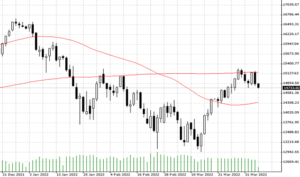

06.04.2022 – So there it is: The Federal Reserve is not shying away from a possible recession. And is once again announcing a determined fight against inflation. Quantitative tightening is to begin in May. Too much, too late? Skepticism is spreading on the stock market.
This is what the bears on Wall Street had been waiting for: According to Fed Director Lael Brainard, a series of interest rate hikes is imminent and a meltdown of the balance sheet is imminent. Most seriously, she said, the Fed would begin Quantitative Tightening as early as May. Moreover, everything could go even more decisively than expected. The stock market’s reaction: The interest-rate-sensitive high-tech stocks in particular reacted in a shocked manner. The Nasdaq 100 currently sits directionless in no-man’s land between the 200 and 50-day lines (below).

Source: Bernstein Bank GmbH
The Federal Reserve’s portfolio, which ballooned to nearly $9 trillion in the Corona pandemic, is being reduced at a much faster pace than in the last contraction from 2017 to 2019, the Fed’s vice chair stressed at a Minneapolis Fed conference yesterday (Tuesday). Brainard verbatim: “Currently, inflation is much too high and is subject to upside risks. (…) It is of paramount importance to get inflation down.” Accordingly, the Fed is “prepared to take stronger action if indicators of inflation and inflation expectations indicate that such action is warranted.”
Behind the curve
Hear, hear – actually the lady was known as a dove so far. So there must be something wrong with the U.S. economy. And worries were already circulating that the Fed was reacting too strongly too late. And slowing down the economy into a recession. Once again, the word made the rounds that the Fed is “behind the curve”, i.e. that it is lagging behind events. Phoenix Capital Research, for example, quipped that the Fed needs to be extremely aggressive – the Taylor Rule states that interest rates need to rise to 9.5 percent. You should Google this complicated Taylor Rule; the explanation would take up too much space here. Anyway, Phoenix Capital Research judged the Fed would trigger a recession in about six months.
Inflation and Ukraine war
Deutsche Bank also just warned of a recession – and not only in the USA. But also in Europe in the next two years. The reasons: The war in Ukraine and high inflation in America and Europe. The current rate of around 8 percent is more than previously expected. The experts therefore expect an interest rate step of 250 basis points from the European Central Bank between this September and next December. The Fed’s tightening will lead to negative yield growth in the U.S. between fall/winter 2023/24, they say.
Our conclusion: we wonder how a new bull market will be forthcoming in these times. The Fed fears inflation more than deflation. Whether that is smart remains to be seen. And more problems are building up right now in eastern Ukraine, the Russian army is regrouping. This has to worry every trader and investor – keep an eye on the realtime news. Bernstein Bank wishes you good luck!
Important Notes on This Publication:
The content of this publication is for general information purposes only. In this context, it is neither an individual investment recommendation or advice nor an offer to purchase or sell securities or other financial products. The content in question and all the information contained therein do not in any way replace individual investor- or investment-oriented advice. No reliable forecast or indication for the future is possible with respect to any presentation or information on the present or past performance of the relevant underlying assets. All information and data presented in this publication are based on reliable sources. However, Bernstein Bank does not guarantee that the information and data contained in this publication is up-to-date, correct and complete. Securities traded on the financial markets are subject to price fluctuations. A contract for difference (CFD) is also a financial instrument with leverage effect. Against this backdrop, CFD trading involves a high risk up to the point of total loss and may not be suitable for all investors. Therefore, make sure that you have fully understood all the correlating risks. If necessary, ask for independent advice. CFDs are complex instruments and are associated with the high risk of losing money quickly because of the leverage effect. 68% of retail investor accounts lose money trading CFD with this provider. You should consider whether you understand how CFD work and whether you can afford to take the high risk of losing your money.7
